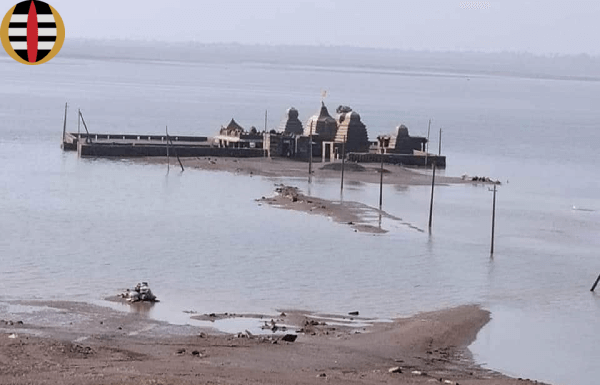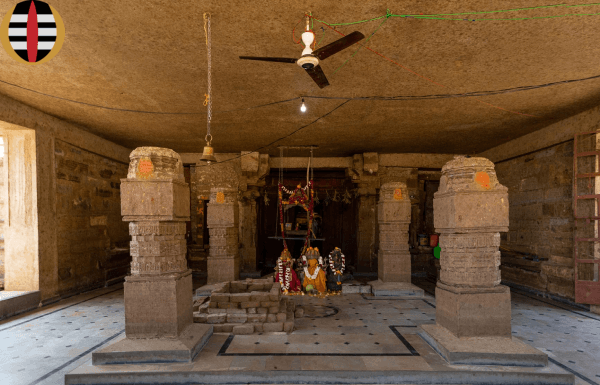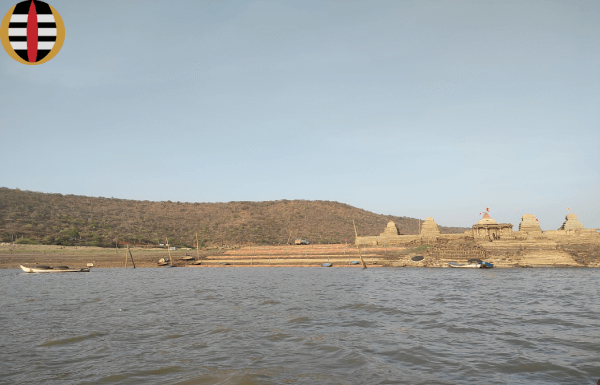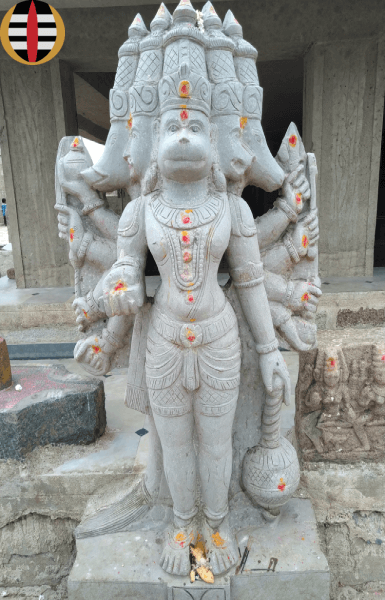Sangameswar Temple
(IPLTOURS)
Sangameswar Temple is a holy Shrine dedicated to Lord Shiva. It is a rare visible and generally submerged in the holy waters of River Krishna. The Shrine considered being the north-west gateway of Srisailam, the 2nd of the 12 JyothirLingas and located at the confluence of the rivers Krishna, Veni, Tungabhadra, Bheemraadi, Malasaahini, Sangameswara and Bhavanasani. The temple generally submerge in River Krishna throughout the year and appears in few months which can reach with great difficulty. Thousands of devotees will reach the temple to visit the Holy Shrine. The historical temple has given shelter to so many sages and is located near Mucchumarri Village, 20 km from Atmakur Town in Kurnool District. The holy place is the confluence of seven rivers and is famous as Sapta Nadi Sangameswar (seven rivers confluence). The temple submerge in water for 8 months and visible only in 4 months. The temple has great historical importance and given shelter to so many sages.
Out of the seven rivers Bhavanasani represents a male name and the rest are with female names. Bhavanasini flows from east to west while the remaining flows from west to east. The rivers mingle with the sea touching Srisailam, where the 2nd JyothirLinga Mallikarjuna and the sixth Sakthi Peeth Bramarambika were established. The priests of the temple perform worship by reaching the temple in the water. The temple submerges in the water when the reservoir filled with full capacity. The Chola Kings established the Jogulamba Sakthi Peeth, 5th among the 18 Sakthi Peeth and Nava Brahma Temple complex 1200 hundred years ago on the banks of Tungabhadra, at Alampur. A village was formed for supply of Lubricant (Oil) used to the wheels of the carts used for shifting of stones in the river. The Village named as Kandenavolu later renamed to the present Kurnool.
Buddhism and Jainism are in widespread in the kingdom under the rule of Chalukya but they adopted Hinduism. The rulers built Budda and Jain temples besides other temples and cave temples. They Kings used to perform their coronations on the banks of Malaprabha River. They built Papanadha and Goraknadh temples here besides Sangameswar Temple at the confluence of Malaprabha and Krishna rivers. They have renovated several old temples in their kingdom pertains to present Mahboobnagar and Kurnool Districts. They built elephant-shaped sculptures around the stage of ten feet height in the Temple. The idols of Sankhanidhi, Padmanidhi, Ganga, Yamuna, Ardha Nareeswar, Harihara, Gaja Lakshmi and Asta Dikpalaka (Eight directions) besides sculptures engraved on the temple door. The idol of a man caught a crocodile and the three stages of man childhood, adolescence and old age on three sides of his face engraved which seems beautiful. After construction of Sangamewar Temple, they have built Nava Brahma Temple complex in the Ashram Area of Sage Jamadagni since there is Jogulamba shrine, in northern area of Tungabhadra River. They further built Kailash Nath temple in the Ellora Caves dissection the hill.
There are different stories on the name of Sangameswar. Bhavanasini River born in the hills of Ahobilam flows and joins with Krishna at the place and the holy place became famous as Saptha Nadi (Seven Rivers) Sangameswar. As per another story, People believe that river Ganga became black due to the purgatory of the sins of the people and gained its natural color of a Swan taking bath in the confluence. It is so the Shrine being called as Nivruthi (recovery) Sangameswar. There is another story believing that Daksha performed Yagna in this place and Daksha insulted Sathi and Shiva in the Yagna. Sathi started yoga moving her five elements from their origin which is not possible even to the Yogis. Fire erupted from her grave status of body and she self immolated in the fire. Since the soul of Sathi Devi released from her body here, the place being called as Nivruthi Sangameswar.
Sangameswar Temple pertains to the Mahabharat period as per local legend. Pandav lost all their wealth and were deported from their kingdom. During their wilderness they came to the present Kurnool area spread in the Nallamala Forest. Udhistar, elder among Pandav ordered Bhima to bring Shiva Ling from Kasi (present Varanasi) to establish in the place. Bhima could not get it in time. Yudhistar prepared Shiva Ling from a Neem Stump and refined in the confluence of Krishna and Tungabadra. Yudhistar established the Shiva Ling on the advice of the Sages and worshipped. Since the Shiva Ling established at the confluence of seven rivers the Shiva Ling became famous as Sangameswar. Bhima arrived afterwards get angry and thrown the Shiva Ling with his hands into the confluence. Yudhistar established the Shiva Ling also on the banks of the river and named as Bhima Ling. The legend says that the Bhima Ling has to be visited primarily before visiting Sangameswar.
There are five shrines of Lord Shiva in the coastal area, known as Pancharama Ksheteras namely Amareswar, Someswar, Ksheera Rameswar, Bheemeswar and Kumara Bheemeswar. Likewise Pancheswar established in Malleswar, Amareswar, Siddeswar, Sangameswar and Kapileswar with the Ling brought by Bhima. Sangameswar Temple primarily constructed on the banks of Krishna River. It was submerged twenty years after construction of Srisailam Dam. People also forget about the existence of the temple. The temple is visible only after the water level reduced in Srisaim Reservoir.
After construction of Srisailam Reservoir, the temples in Alampur including Sangameswar Temple affected drown with the water in the reservoir and the Archlogical Department has shifted and reconstructed the temples in other places. The Sangameswar and Papanasana Temples were re-built beside to the Alampur road. A wall was constructed between the river and Nava Brahma Temples to protect from the flood water. Another part of Sangameswar Temple was rebuilt at Jagannadh Gattu near Kurnool. The Chariot was also shifted to here. The Triveni Sangam statue was shifted to public gardens at Hyderabad. Bujangeswar Temple was constructed at Nandikotkur. The main Sangameswar Temple is still in the drowned water. The temple is visible only in the months from March to June as per descending of water in the Srisailam Reservoir and thousands of devotees reach the temple for worship. Pilgrims may visit all the temples with their stay in Kurnool.
The glorious Sangameswar Temple became ruined due to submergence in water. The present temple was constructed two hundred years ago by the local people. The visible debris around the bailey clearly discloses that the temple was constructed in a vast area. The gateways on the north, west and southern sides were ruined due to drown in the water. The present main temple is visible normal. The Porch was ruined and the inner temple and sanctum are visible. Sangameswar worshipped in the sanctum. Behind to Sangameswar, Sri Lalitha Devi on the left and Vinayak on the right are worshipped. Since the old temples were collapsed, the statues were shifted to the sanctum of the main temple. The temple drowns in the water and the daily worship could not be performed. It is really the greatness of Sangameswar that the Shiva Ling made with Neem Stump which drown in water for eight months years together appear intact still today. There is a foot print of Maa Gayatri in the form of Gomatha in the Viswamitra Cave on the hillock who perform penance about Maa Gayatri in Tretha Era and the foot print being worshipping at preaent.
Pilgrims may reach the Shrine at a distance of 20km from Nandikotkur and 55km from Kurnool in these two different routes. Pilgrims may reach Sangameswar at a distance of 6 km from Mucchumarri by auto or jeep with travel of 16km from Nandikotkur by bus. Pilgrims may also reach Kapileswar from Atmakur by bus and reach the Shrine at a distance of 5 km in auto or jeep from Kapileswar. Devotees travel in own vehicles may reach either way. APSRTC will fly busses direct to the Shrine from all the cities during festivals like Maha Shivaratri. The devotees of Telangana may travel from Mahboobnagar to Somasila by bus and reach the Shrine by motor boat.
Photo Gallery
IPLTOURS – Indian Pilgrim Tours
























